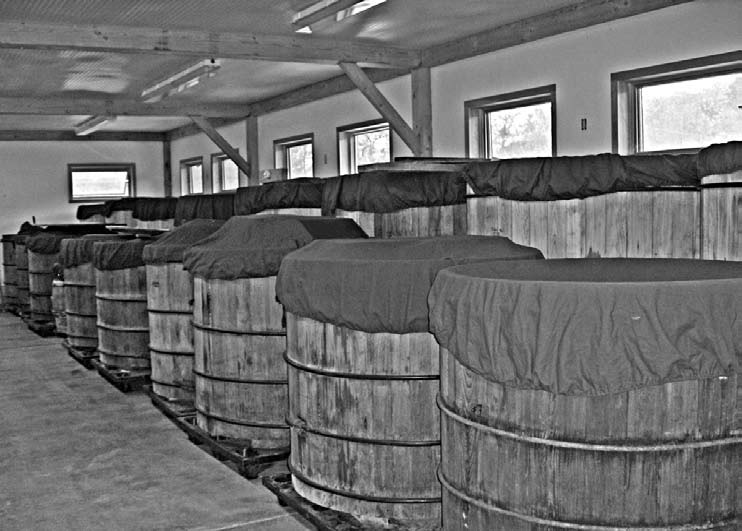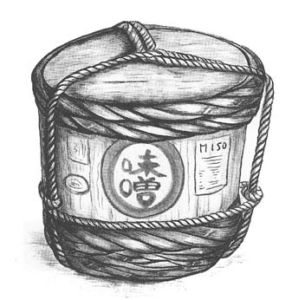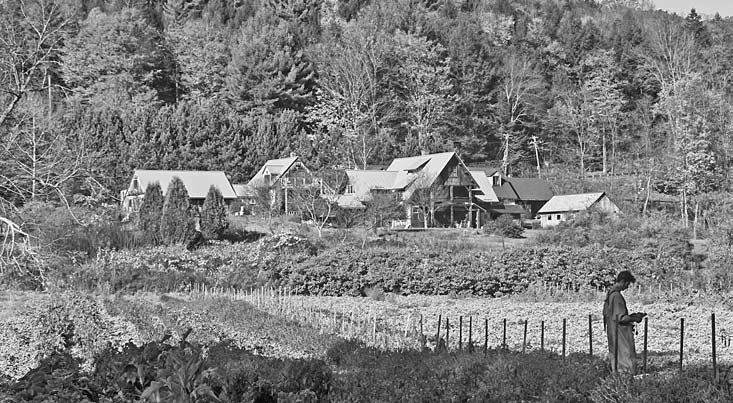


Autumn is a time of great abundance and activity at South River Farm and South River Miso Company. While nature is slowly turning inward for its long winter sleep, we are quickening to the pace of our busiest season. All the vats from the summer fermentations are opened for harvest. And although we are now producing miso throughout the year, winter is the season we receive most orders and ship the most miso.
As cold nights turn the leaves to gold, the fire beneath the great kettle glows. Sweaters and coats come out of storage as our appetites grow. Colorful, plump, and amusing winter squash, sleek hardy leeks, and deep green kale come in from the farmland to grace our tables.
How perfectly miso complements the tastes of autumn with its savory, salty depth and wide array of colors: the rich russet Hearty Brown Rice, the cheery yellow Golden Millet and Chick Pea, burgundy Azuki, and the caramel Sweet Tasting Brown Rice.
Greetings to all of you, new friends and old, and thank you for your continued interest, connection, and support.
“Although a variety of naturally made miso is available in natural food stores, South River Miso due to its ingredients and manufacturing methods is a unique cultural artifact, a remnant of taste and quality from Japan’s centuries old handcrafted miso tradition.”
—John Belleme, author of Cooking with Japanese Foods
Miso is a delicious, all-purpose, high protein seasoning which has been an important staple in Japanese cuisine for over 2000 years. It is used for many of the same purposes that we in the west use salt. Miso is usually made from a combination of soybeans, cultured grain, and salt by a unique fermentation and aging process which was elevated to a state of fine craftsmanship in old Japan.
Unpasteurized miso is a living fermented food containing natural digestive enzymes, Lactobacillus, and other microorganisms which aid in digestion, and ward off and destroy harmful microorganisms, thereby helping to create a healthy, active immune system.
Research has also shown that miso can help cleanse the body of toxins from nicotine, radiation, and atmospheric pollution as well as helping to dissolve accumulations of cholesterol. Overall miso has an alkalizing effect on the bloodstream, a condition thought to promote resistance to disease.*
In traditional Japan, miso gained a special place in the minds and hearts of generations who came to enjoy miso soup as an essential part of their daily life.
* William Shurtleff, The Book of Miso (Ten Speed Press: 1983), chapter 2

German (pronounced Her-mon) Perico is in his fourth season with South River Miso as the production assistant. German grew up in Columbia, S. A., and came to the states at age 18 to study advertising. He worked in advertising for a little while during college, but didn’t like it very much. “It was not enjoyable for me,” he says. “It was just a career… Then I came to the realization that the real career is within you. Life is a career! It doesn’t have to be a profession, but you can live with professionalism, and that’s living with integrity and awareness.”
German works with production manager Yukio Doyama. Together they make about 100,000 pounds of miso per year, with some additional help during the summer months. The production calendar follows a quiet, steady rhythm which repeats itself every week throughout the year: steaming the grain, making the koji, cooking the beans over the wood fire, treading and mixing the raw miso which is then put into the fermentation vats.
German believes that his first job is to develop attention, commitment, and presence through his work in order to contribute his best. “I think the way to develop is by serving others through selflessness, and that takes work. I am serving the people that we make this miso for, and I am serving the company. Yet we have a divine heritage that links us all together. So, who am I serving? I am serving the highest in me.”
German also cleans the production rooms every Friday afternoon. After a week full of outward activity, the miso shop becomes a spotless, shining temple of silence and peace. German says, “The immersion in what you do, whatever it is, whether you own the company, or wash the toilets, makes no difference, as long as it comes with the intention of doing good.”
Many thanks to Max Breiteneicher for his photos and writing skills, for helping us with this Newsletter. Max writes for our most local newspaper, the Shelburne Falls Independent. Visit his web site (www.maxworks.org) for a wide range of articles including an in depth interview with Christian Elwell about miso making at South River. Newsletter design and production by Jeff Potter, the Independent’s editor and publisher.
We are reprinting information here about this important cancer research for new customers, and for those who may not have seen it in our past newsletter, three years ago.
An article published in the English Journal of the National Cancer Institute in June 2003, reports breast cancer risk was reduced by one half in Japanese women who ate three or more bowls of miso soup on an almost daily basis! Conducted by the Japan Public Health Study of Cancer and Cardiovascular Disease, the report monitored 21,852 women from 1990 to 2000. Post-menopausal women showed the highest reduction of risk.
With high quality miso available in the USA, we too can enjoy the protective health benefits of this miraculous food.
Reference: Soy, Isoflavones, and Breast Cancer Risk in Japan, by Yamamoto, S. in Journal of the National Cancer Institute Vol. 95, pgs 906-913, June 18, 2003. (To read an abstract of the article on the web go to http://highwire. stanford.edu/cgi/search and enter the reference information.)

Miso Mighty (Better ‘n Coffee) Instant Drink

I received my order yesterday. This is incredible miso! I made the breakfast porridge. It is amazing. It is a pleasure doing business with South River Miso. I am pleased wit your product and your service. It is refreshing to deal with a company where excellence permeates all aspects of the business.
– LM, Akron, OH
Dear Deb [Deb Duchin receives all our orders, ed.]
Your shipment arrived today in its beautifully engineered packaging. Thank you all so much for these gifts of your lives.
– GN, Sacramento, CA
Thank you very much! I had never heard of miso before my first order. I really felt a difference after drinking the first cup on the first day! My friends, family, & co-workers already think I’m over the edge… They just shake their heads while I am drinking my miso! 🙂 🙂
The other jar went to my co-worker. We were looking for an alternative to her drinking coffee and that is how I found your web site. She had asked me, “What is miso?” I said” I don’t know, but I will look it up on the web.” I am glad your website came up when I did a search… She has been drinking her miso everyday and has been off coffee since. Yeah!
– JB, Broken Arrow, OK
I recently ordered 4 jars of your miso and sampled the Dandelion Leek Miso last night. WOW! I was blown away with HOW FABULOUS IT IS! The New York Times article [see NYT, April 11, 2oo7, ed.] did not do it justice. It is so rich, full-bodied, winey, savory, satisfying, and amazing. I just had some with my vegetables as a dip, and loved it. I am really looking forward to trying all the others I ordered. Thank you so much for making such a wonderful product and bringing so much pleasure and delight into my life. Best wishes,
– JU, Dedham, MA
“…each kind of miso has its own, rich, complex flavor and its own purpose—whether it be to enrich a broth or stock, to season a sauce or marinade, to work as a pickling agent, or to stand on its own, spread on vegetables or layered into casseroles. Miso is healthy and versatile and simple in composition, but its real magic comes from its ability to transform—even to elevate—other ingredients onto another level altogether.”
—Hiroki Shimbo-Beitchman, Saveur Magazine May/June 1998.
PH: 413.369.4057
Information
Sign up for our newsletter, South River Currents, where we share stories, photos, recipes, videos, and more.